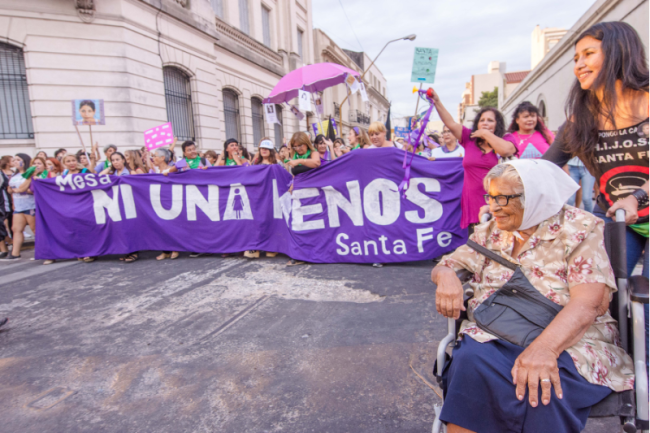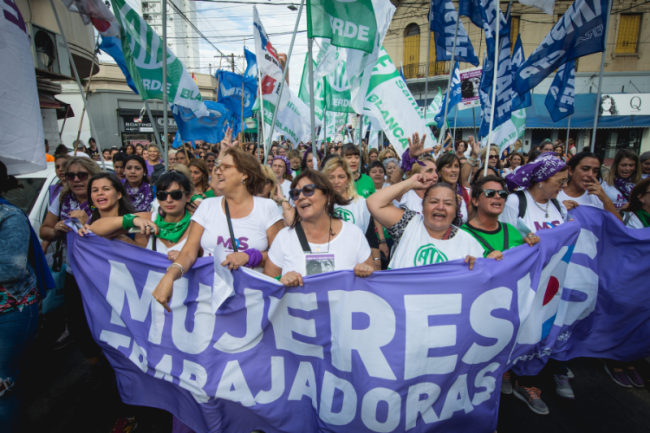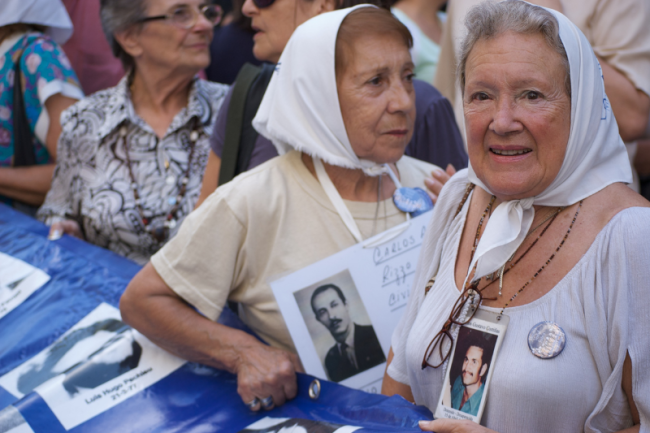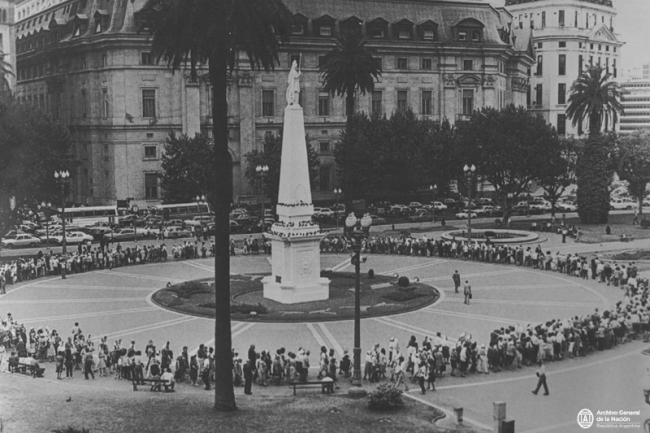
This piece appeared in the Summer 2024 issue of NACLA's quarterly print magazine, the NACLA Report. Subscribe in print today!
Leer este artículo en español. Translated from Spanish by NACLA.
Dozens of banners occupy the horizon as drums and enthusiastic chants ring out. Hugs are shared and greetings exchanged from a distance. Among the thousands who have taken to the streets in Argentina for the International Strike of Women, Lesbians, Travestis, Trans, and Nonbinary People on March 8, the crowd makes way for a handful of women in white scarves: the Mothers and Grandmothers of Plaza de Mayo.
Many today would say that an invisible thread links the feminist movement with these militant women, and it is common nowadays to represent the Mothers and Grandmothers of Plaza de Mayo as a naturally constitutive reference point for feminist activism in Argentina. History, however, is not so linear. At the dawn of the return to democracy, feminists identified with the Mothers and Grandmothers, whose ideals they saw as close to their own; yet “the majority of the Mothers, with exceptions, do not want anything to do with feminism,” as one of the mothers, Nora Cortiñas, pointed out in an interview years later. Devoted to the search for their disappeared sons and daughters, even the Mothers and Grandmothers’ participation in the National Women’s Encuentros at the end of the 1980s was aimed at presenting human rights claims and not at questioning gender norms.
So, what is the relationship between the search for the disappeared and the mass feminist movement of the present? How has human rights activism from the 1980s onwards impacted the political language available to frame other struggles and demands? While human rights discourse is legitimate for a wide range of social activism, for feminisms the particularity lies in the naturalization of this discourse: many feminists argue that their link to human rights demands has never been about political tactics, but rather is a natural extension of their own lives.
Following the work of Mercedes Barros and Natalia Martínez Prado, however, we argue that the “friendly bond” between feminisms and the Mothers and Grandmothers of Plaza de Mayo is neither natural nor obvious. Rather, it is the contingent—that is, political—result of a series of shifts within feminist activism over the last four decades. Specifically, we are interested in thinking about the post-dictatorship rupture through which feminism lost the epithet of purity assigned to it in the 1970s and began in the following decades to be contaminated, going from pure to plural, from plural to popular, and from popular to massive, thanks to new layers of meaning inscribed in its name.
We want to recover this history to analyze the echoes of the Mothers and Grandmothers of Plaza de Mayo in the dynamic landscape of contemporary feminist activism. We argue that the massification of 21st century feminisms, with the well-known slogans “Ni Una Menos” and “Aborto Legal,” has found the conditions of possibility in a first plural becoming of feminisms in the 1980s and a second popular becoming in the 1990s, thanks to the politicization of the search for the disappeared carried out by the Mothers and Grandmothers of Plaza de Mayo.

From Pure to Plural: Women’s and Feminist Activism in the Return to Democracy
On March 24, 1976, the Argentine Armed Forces carried out a coup d’état, installing a dictatorship characterized by repression and forced disappearances. As part of the so-called “National Reorganization Process,” the military government implemented a covert plan of persecution, kidnapping, torture, and extrajudicial executions with the aim of eliminating those considered “subversives” and establishing a neoliberal economic model. As a result, 30,000 people were disappeared.
During the return to democracy after the end of the dictatorship in 1983, the Multisectorial de la Mujer, a space made up of a diverse array of groups, called for a mobilization in the Plaza del Congreso on March 8, 1984. Among the more than 3,000 participants were women politicians, women from cultural groups and trade unions, housewives, and members of women’s associations and feminist organizations. The feminism that emerged along with the return of democracy in the 1980s marked a turning point in the movement due to the return of exiled activists and the importance of party institutions, which enabled a change in the way of conceiving “traditional” party and state political practice. For the feminists of the 1970s, political parties and the state were bureaucratic, hierarchical, and patriarchal apparatuses, and feminists therefore sought “another way of doing politics.” In the following decade, feminists let themselves be immersed in the democratic opening and began to participate in the political processes enabled by the transition.

For the activists of this new decade, the feminism of the 1970s had been bourgeois, apolitical, and colonial. That feminism, as they saw it, had imported theories from the Global North without adapting them to the Latin American context and without articulating with other struggles, thus promoting a partial and elitist representation of the women’s universe. In the 1980s, then, they set out to foster a local and plural movement in which multiple ways of “being feminist” could fit. Thus, the National Women’s Encuentros—held in Argentina since 1986 and since 2022 called the Plurinational Encuentro of Women, Lesbians, Travestis, Trans, and Nonbinary People—“belong to everyone.” Feminists, women, trade unionists, academics, politicians, and so on—they all have a place in this new plural feminism. Though not without tensions: trans women and travestis were excluded from the Encuentros in the 1990s and early 2000s, for example.
A decade before the first Encuentro, on April 30, 1977, in the midst of the civil-military dictatorship, 14 women gathered in the Plaza de Mayo to deliver a letter to the de facto president demanding information on the whereabouts of their children. With no response from the national authorities and forced to walk in circles around the plaza because of the ban on the right to assembly, the Mothers of Plaza de Mayo introduced, Thursday after Thursday, an unexpected and novel form of political mobilization. Two years later, on August 22, 1979, the group became legally constituted as an association.
The Mothers’ strategy of presenting themselves as “only mothers”—the conservative place that the dictatorship itself assigned them as caretakers of the home, family, and children—was quite successful, though their calculation that they would not face repression was inaccurate. By taking motherhood out of the private sphere and into the public arena, they politicized their supposedly natural obligations of watching over the destiny of their children and redefined their role as “mothers.”
Almost the entire feminist arc of the 1980s identified with the political struggles of human rights movements, especially with the Mothers and Grandmothers of Plaza de Mayo. Laura Rossi (pseudonym of Laura Klein) went so far as to state in 1985 that “the Mothers put into practice the founding motto of Second Wave feminism of the 1960s: the personal is political.” Seen as mothers who stop being mothers to burst into the political arena through struggle and mobilization, they are seen as breaking with the traditional order, desecrating motherhood to the point of transforming it into subversion.

The politicization of the motherly role through the socialization of motherhood complicates the idea that a shared gender condition is what articulates feminists’ identification with these women. As Mercedes Barros explains, for the Mothers, a “lack that defines them” shapes their way of taking action: by making the disappearance of each of their children stand in for all disappearances, they transformed an individual search into a collective struggle. As the late Hebe de Bonafini, a founding member of the Mothers, explained in a 2007 interview:
We socialized motherhood in a very, very hard political moment, when we were accused of being mothers of terrorists and terrorist mothers. And faced with such a strong accusation, all mothers were very afraid. Then, a journalist would come along and ask her, and she would say: ‘My son didn’t do anything,’ ‘They took him because of his friend,’ ‘They took him because of his wife,’ ‘They took him because of his cousin.’ And then one day, we got together and talked a lot with other compañeras, and we said that what we had to do was socialize motherhood and become mothers for everyone. Then, no mother was going to be able to say: ‘My son did nothing’ … We took the son’s name off the handkerchief, and we no longer carried the photo with the name… So that when they come to ask the mother, she says: ‘Yes, we are mothers of 30,000.’
In the words of another founding mother, Nora Cortiñas: “We are no longer mothers of a single child, we are mothers of all the disappeared. Our biological child became 30,000 children. And for them we gave birth to a totally political life in the street.” The Mothers thus define themselves as “daughters of their children”—birthed by their children, by their disappearance. (Re)born through an unthinkable politicization.
From Plural to Popular: “Piquete y Cacerola, la Lucha es una Sola”
In the 1990s, as the neoliberal model and its resulting impoverishment advanced in Argentina, new forms of resistance and social organization became channeled in public space and in the streets. First known as “puebladas,” then as “fogoneros,” pickets—blockades of streets, roads, entrances to factories, or other strategic places, carried out by unemployed or precarized workers—quickly became a strategy of organized and visible protest throughout the country, known as the piquetero movement. One of the first manifestations of discontent in this era was expressed in a 1991 protest by the wives and mothers of mine workers in Sierra Grande, Río Negro, when they blocked Route 3 to demand the closure of the Hipasam iron ore mine.
Read the rest of this article, freely available online for a limited time.
Malena Nijensohn holds a BA in Philosophy and a PhD in Gender Studies from the University of Buenos Aires and is a researcher at CONICET. She is editor of Los feminismos ante el neoliberalismo (La Cebra, 2018) and author of La razón feminista. Políticas de la calle, pluralismo y articulación (Cuarenta Ríos, 2019).
Luciana Serrano is an independent researcher and educator who specializes in multidisciplinary projects on human rights. She is a founding member of Cooperativa Espacial, a research space that uses critical spatial practices to promote knowledge and social justice alongside like-minded collectives.

